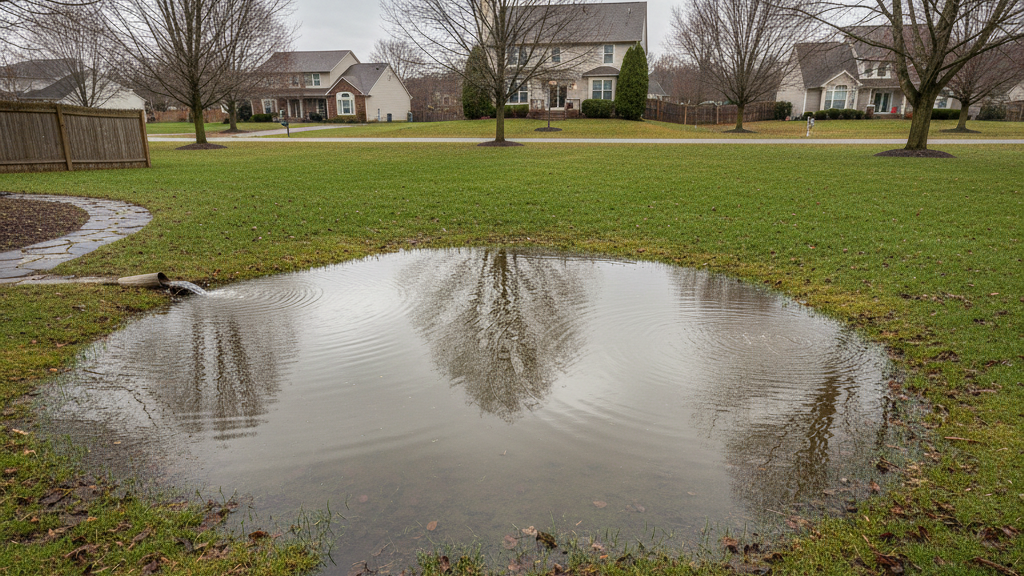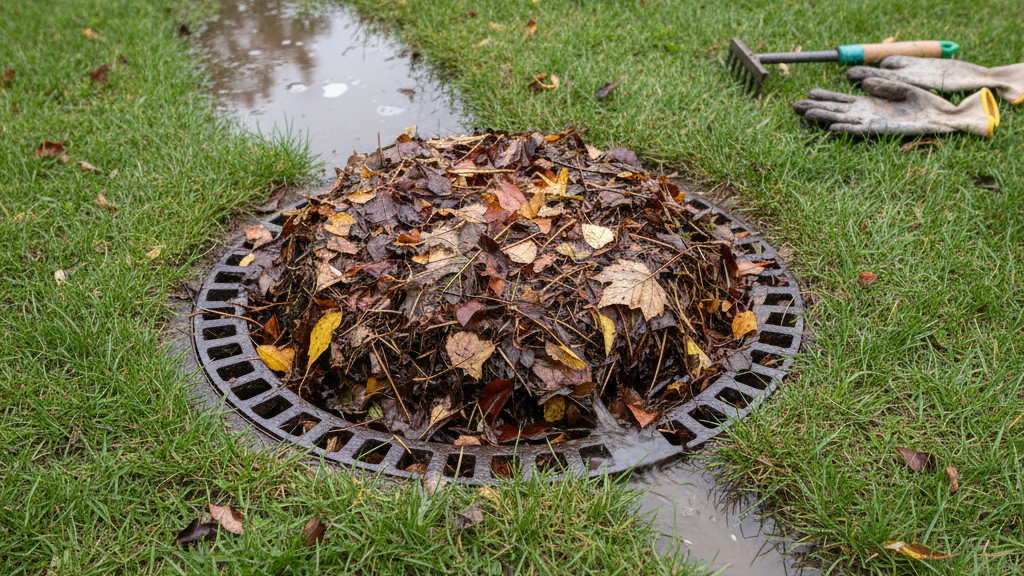
As temperatures drop and wetter weather approaches, low spots in your yard can turn into persistent puddles or even mini ponds. Once winter sets in, ice, freeze‑thaw cycles, and saturated soil compound the damage—leading to drainage problems, soggy turf, or even structural harm near foundations. The good news: with timely intervention, you can eliminate ponding issues now and protect your property through the colder months.
Why Address Ponding Before Winter?
- Prevent ice hazards: Water that sits can freeze, becoming a slip risk.
- Avoid turf and plant damage: Prolonged saturation starves roots of oxygen.
- Reduce soil erosion or shifting: Freeze‑thaw cycles expand and contract wet soil.
- Protect your home’s foundation: Standing water near structures can infiltrate basements or cause frost heave.
Step 1: Survey Your Yard & Identify Trouble Zones
Walk your property during or right after a rainstorm to see where water tends to accumulate or flow slowly. Mark depressions—especially those near driveways, patios, foundations, or low‑lying lawn areas. Use a simple level, string line, or water level tool to gauge how deep and extensive those low spots are.
Step 2: Select the Right Fix Strategy
Below are common approaches (alone or in combination) to resolve ponding problems:
| Method | When to Use It | Pros / Cons |
|---|---|---|
| Topdressing & Regrading | Shallow depressions in lawn areas | Low cost; improves surface grade. But may require periodic reapplication. |
| French Drains or Trenching | When water flows or remains long in a line toward a low point | Redirects water underground. Requires excavation and proper slope. |
| Dry Wells / Underground Storage | When water must be held temporarily and released slowly | Helps manage peak flow. Needs good soil absorption and maintenance. |
| Installing Swales / Shallow Channels | To guide surface flow away from sensitive zones | Less intrusive. Works only if you have a drainage outlet downhill. |
| Soil Amendment (Adding Sand / Gravel) | Clay‑heavy, poorly draining soils | Improves infiltration. May not solve extreme ponding alone. |
Step 3: Regrading & Filling Low Spots (DIY Option)
If the ponding issue is minor, you may be able to fix it yourself:
- Lightly dig or loosen the soil in the depression so that new fill will bond with the existing earth.
- Use a mix of topsoil and sand (or gravel for improved drainage) to gradually build up the area. Don’t overfill—create a gentle slope away from the low point.
- Compact in thin lifts (2–3 inches at a time) to reduce settling.
- Reseed or install sod and keep well watered to promote root establishment.
- Monitor after rain and add more material or adjust slope if ponding persists.
Step 4: Installing Drainage Solutions (Pro Approach)
In many cases—especially for larger or chronic ponding—you’ll want to employ drainage systems. That’s where Homeward Environmental’s specialization in yard drainage, French drains, and buried downspouts comes in. :contentReference[oaicite:0]{index=0}
- French Drain Installation: We dig a trench at a slight grade, line it with filter fabric, lay perforated pipe, and fill with gravel. The drain captures and redirects subsurface water away from where it’s damaging.
- Buried Downspout Extensions: Instead of letting roof runoff fall near the foundation, we connect your downspouts to underground piping that carries water to a safe discharge point.
- Swales & Surface Channels: We can regrade or shape your yard to create gentle channels that send surface water where it belongs—without disrupting your landscaping.

Step 5: Maintenance & Winter Preparation
Once you’ve addressed low spots and installed drainage fixes, follow these tips to keep your system effective through winter:
- Clear debris: Leaves, sticks, and mulch can clog drain inlets, so clean them before freeze-up.
- Inspect outlets: Make sure water can flow freely out of pipes or swales and is not blocked by ice dams.
- Avoid heavy traffic in newly repaired areas: Let sod and soil settle and root.
- Watch for settling: Freeze‑thaw cycles may cause mild settling; reapply soil or topdressing in spring if needed.
Why Trust Homeward Environmental?
At Homeward Environmental, we specialize in personalized yard drainage solutions, regrading, culverts, buried downspouts, and more. :contentReference[oaicite:1]{index=1} We believe every property is unique, so we design systems that suit your land’s contours and your home’s structure. Whether you need one low spot repaired or a full drainage overhaul, we bring expertise, care, and long-term solutions to the table.
Take Action Before Winter Sets In
Don’t wait until the snow melts to realize the damage winter did. Getting your low spots fixed and drainage working now can save you time, money, and hassle come spring.
Contact us today to schedule a free inspection and get started on protecting your yard and home before winter arrives.
